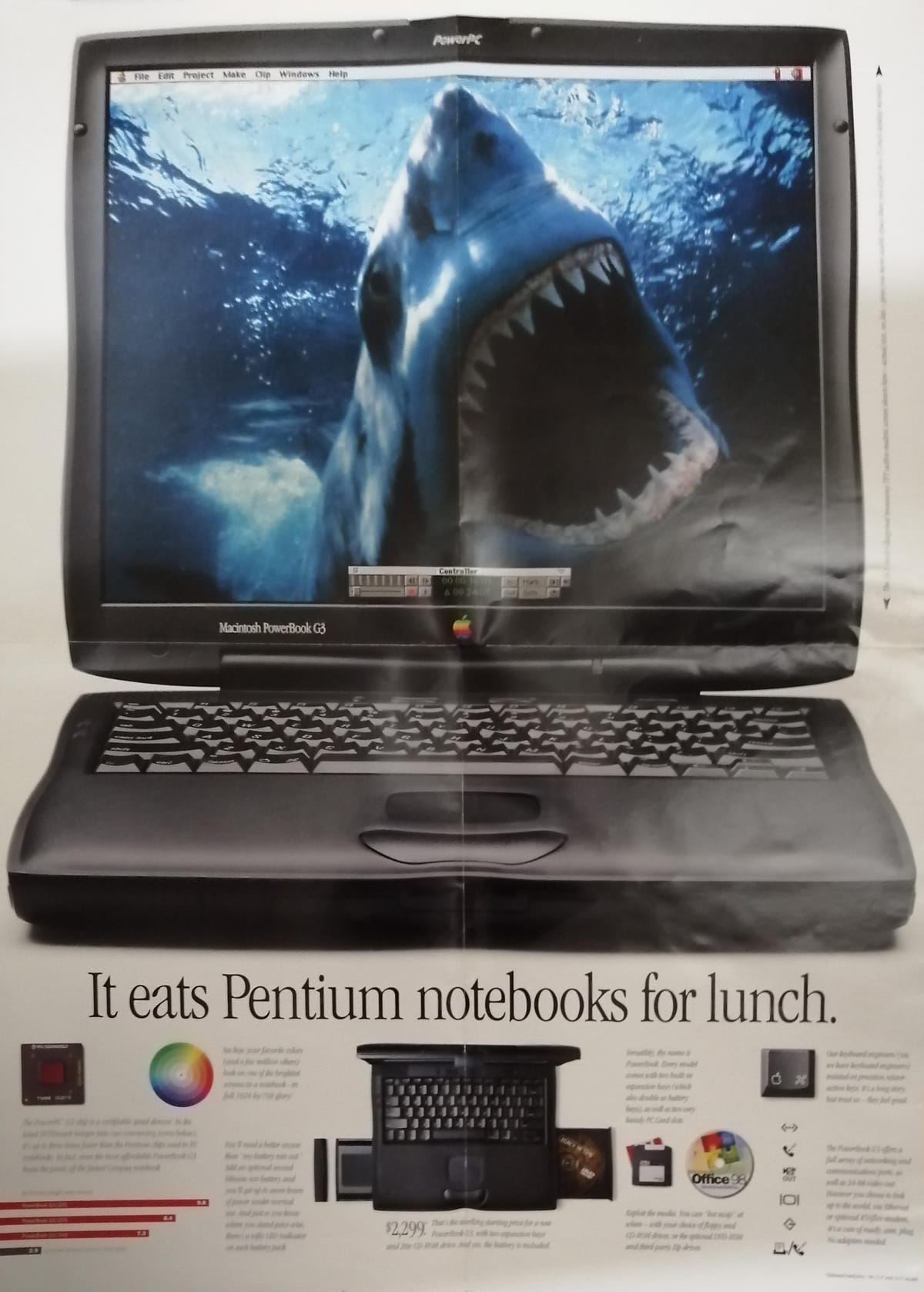How I Caught the Apple Bug

Today, Apple once again introduced new hardware at one of their signature events—these carefully orchestrated presentations that take place multiple times a year. Each time, I’m reminded of my personal connection to the brand and where it all began for me.
It was the late 1990s, and as a teenager, I came across an Apple newspaper ad that instantly caught my eye. It featured a sleek black notebook with smooth, curved edges—the PowerBook G3. On its display was the image of a shark about to attack, accompanied by the bold caption: "It eats Pentium notebooks for lunch."
At the time, Apple computers were a rarity in Germany, mostly used by professionals in desktop publishing. In my immediate surroundings, an art teacher at my high school used one to create print media, and the father of a friend—a publishing professional—worked on one as well. But these were the standard beige Mac desktops, visually indistinguishable from their PC counterparts unless you looked closely.
The PowerBook G3, however, was different. It wasn’t just a tool; it was a statement. Its design went far beyond the purely functional aesthetic of the beige boxes, transforming into an organically shaped object of beauty. I saw a parallel to the works of Spanish engineer and architect Santiago Calatrava, whom I had admired from an even earlier age. His designs—often inspired by human anatomy—turned utilitarian structures like train stations and bridges into usable sculptures that enriched their surroundings (and, at times, financially strained their clients). To me, the PowerBook G3 belonged to this world of organic shapes I longed to be part of.
The advertisement reinforced this feeling. It positioned Apple as the rebellious, forward-thinking alternative to the dull, gray “Wintel” world. The propaganda worked—I was hooked.
Hunting for the PowerBook
Determined to see the PowerBook G3 in person, I set out to find it. In Munich, there were only two easily accessible stores selling Apple products. One was a large department store in the city center, where Apple computers were relegated to a forgotten corner of the basement. The few models they had were crammed onto two tiny shelves—a fitting metaphor for Apple’s niche status at the time. Many people had never even heard of the brand, let alone understood what made it different from a Windows PC.
The second store was in a street near the main train station—right across from a porn cinema, no less. Unlike the department store, this shop was dedicated exclusively to Apple products. The all-male staff stood behind a counter that separated customers from the open back area of the store. They were highly knowledgeable, handled in-house repairs, and clearly had hands-on experience with the products they sold. It felt less like a retail store and more like an exclusive club. Customers and staff chatted at length, many seemingly on a first-name basis. This was a small, tightly knit community in a time when being part of one still required showing up in person.
Looking back, I’m amazed at how much Apple has changed since those days. The iPhone was still almost a decade away, and the company had only just begun dipping its toes into the consumer market with the launch of the iMac in 1998. But as Apple gained traction—especially with the rise of iTunes and the iPod in the early 2000s—their reach expanded. The once-obscure Apple store near the train station eventually moved to one of Munich’s prime shopping streets. It tripled in size, and instead of feeling tucked away, it now showcased Apple products in a brightly lit, carefully designed space with tall glazed arcades facing the street. Some of the original staff remained, but now they wore sleek, matching store-branded t-shirts. Coming from the old location, it all felt strangely out of place.
By 2013, Apple had opened its own flagship retail store just a minute away from Munich’s main square. The company’s transformation from a niche player to a mainstream giant within a decade was staggering.
The PowerBook That Started It All
Back in the late ’90s, I had already decided that I wanted to be part of this “Think Different” movement—despite not even having a pressing need for a computer as a high school student. Nevertheless, I made it my mission to save up for that incredible PowerBook. It took me two years of working part-time at Munich Airport’s cargo area, shuffling airway bills between company and customs offices while dodging speeding forklifts. With a generous contribution from my parents, I finally had enough.
In 2001, I bought a second-hand PowerBook G3 Pismo for what was then an outrageous amount of money. It became the first internet-enabled device in our household, marking the beginning of my engagement with all things digital—packaged in a product that was as much a work of design as it was a piece of technology.
Over the following years, I purchased several more Apple computers: the PowerBook G4 17-inch before heading to university, later switching to a MacBook Pro 15-inch during my studies, and eventually a Mac Pro. But over time, my relationship with Apple began to change.
That, however, is a story for Part 2.